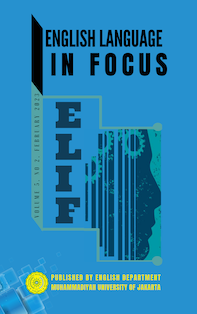Tracing Gender Perspectives in Literature: The Search for Islamic Feminism in Faith and the City by Hanum Rais
DOI:
https://doi.org/10.24853/elif.5.2.91-98Keywords:
Gender Perspectives, Islamic Feminism, Woman LiteratureAbstract
This is the study with a concern to reinterpret the feminist ideas on an autobiographical fiction written collaboratively by Islamic woman author, Hanum Rais and her husband, Rangga Almahendra. Taking Faith and The City as the studied material, this study aims to investigate the occurrence of gender identity, traditional gender roles and stereotypes of Asian Muslim men and women in United States and how the story reflects the woman’s struggle in choosing between domestic responsibilities and aspiring career and the man’s struggle in maintaining his relationship without losing their Islamic identity. The method of this study is close reading by identifying gender identity, traditional gender roles and stereotyping of male and female character and representation of man and woman struggle following the Islamic values. Based on the findings, the researcher concluded that both characters represent struggle of husband and wife who return to Islamic teachings and uphold the values taught by the Qur'an and Hadith to reach gender equity. Both figures tend to making adjustment for giving contribution to public spheres without leaving their faith and values by adhering to the gender role and gender identity and breaking the negative stereotypes surrounding the Islamic couple.References
Primary Text:
Rais, H. S., & Almahendra, R. (2015). Faith and the City. Jakarta: PT Gramedia Pustaka Utama.
Secondary Texts:
Arivia, G., & Subono, N. I. (2017). A Hundred Years of Feminism in Indonesia An Analysis of Actors, Debates and Strategies [PDF]. Indonesia: Friedrich-Ebert-Stiftung.
Badran, M. (2005). Between secular and Islamic feminism/s reflections on the Middle East and beyond. Journal of Middle East Women's Studies, 1(1), 6-28. doi:10.2979/mew.2005.1.1.6
Badran, M. (2011). From Islamic feminism to a Muslim holistic feminism. IDS Bulletin, 42(1), 78-87. doi:10.1111/j.1759-5436.2011.00203.x
E., & Rohman, S. (2016). Feminisme. In Teori dan Pengajaran Sastra (2nd ed., pp. 131-160). Jakarta, Jakarta: RajaGrafindo Persada.
JAWAD, H. (2003). Muslim Feminism: A Case Study of Amina Wadud's "Qur'an and Woman". Islamic Studies, 42(1), 107-125. Retrieved November 1, 2022, from https://www.jstor.org/stable/20837253?seq=1&cid=pdf-reference#references_tab_contents
Kynsilehto, A. (Ed.). (2008). Islamic feminism: Current perspectives. Tampere: Tampere Peace Research Institute.
Liasna, T., & Ansari, K. (2017). Gender perspective in the novels Padang Bulan and Cinta di Dalam Gelas by Andrea Hirata: A study of structure and feminism literary criticism and its relevance as the literature reading materials for high schools. Humanus, 15(2), 207. doi:10.24036/jh.v15i2.6587
Nugraha, D., & Suyitno, S. (2019). Representation of islamic feminism in Abidah El Khalieqy’s novels. LITERA, 18(3), 465-484. doi:10.21831/ltr.v18i3.27012
Wadud, A. (1999). Qur'an and woman: Rereading the sacred text from a woman's perspective. New York: Oxford University Press.
Wiyatmi. (2013). Menjadi Perempuan Terdidik: Novel Indonesia Dan Feminisme. Yogyakarta: UNY Press.
Published
Issue
Section
License
Authors who publish with this journal agree to the following terms:
- Authors retain copyright and grant the journal right of first publication with the work simultaneously licensed under a Creative Commons Attribution License that allows others to share the work with an acknowledgment of the work's authorship and initial publication in this journal.
- Authors can enter into separate, additional contractual arrangements for the non-exclusive distribution of the journal's published version of the work (e.g., post it to an institutional repository or publish it in a book), with an acknowledgment of its initial publication in this journal.
- Authors are permitted and encouraged to post their work online (e.g., in institutional repositories or on their website) before and during the submission process, as it can lead to productive exchanges, as well as earlier and greater citation of published work (See The Effect of Open Access).


